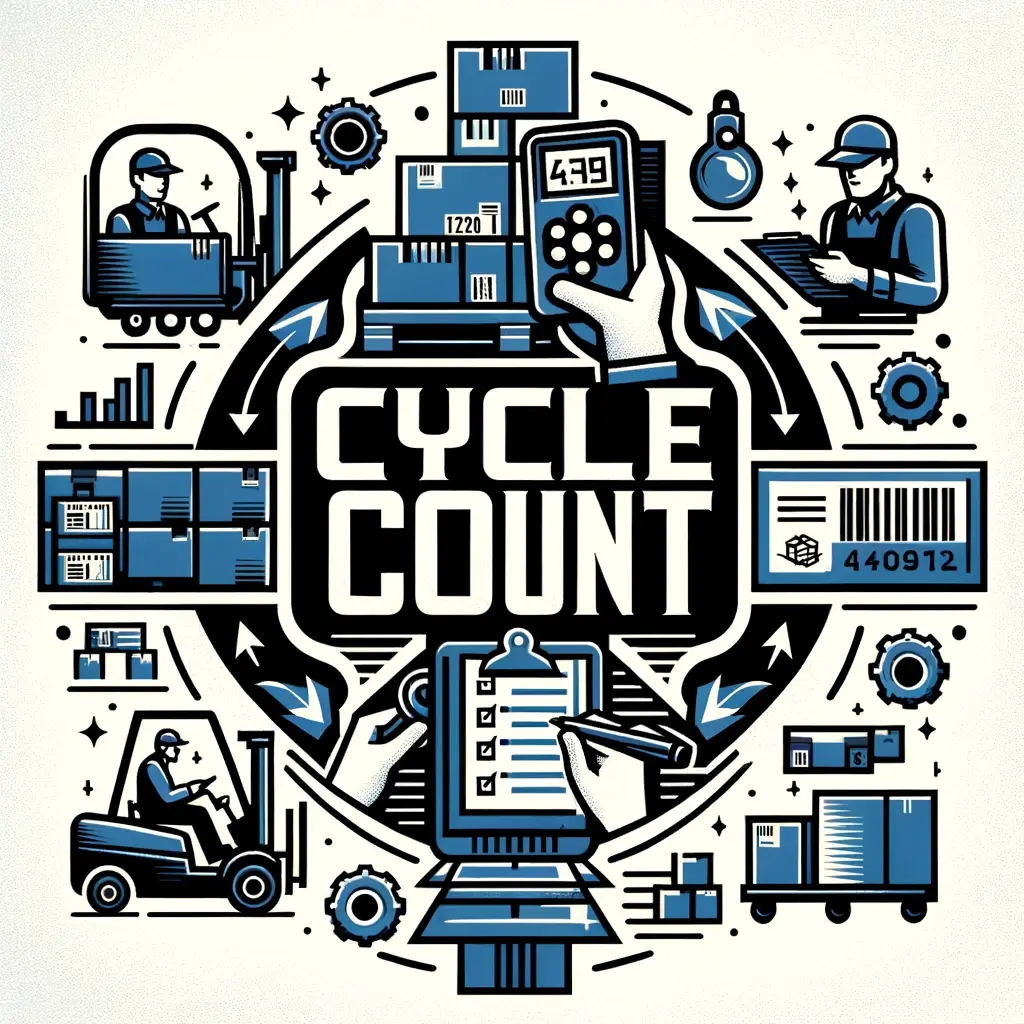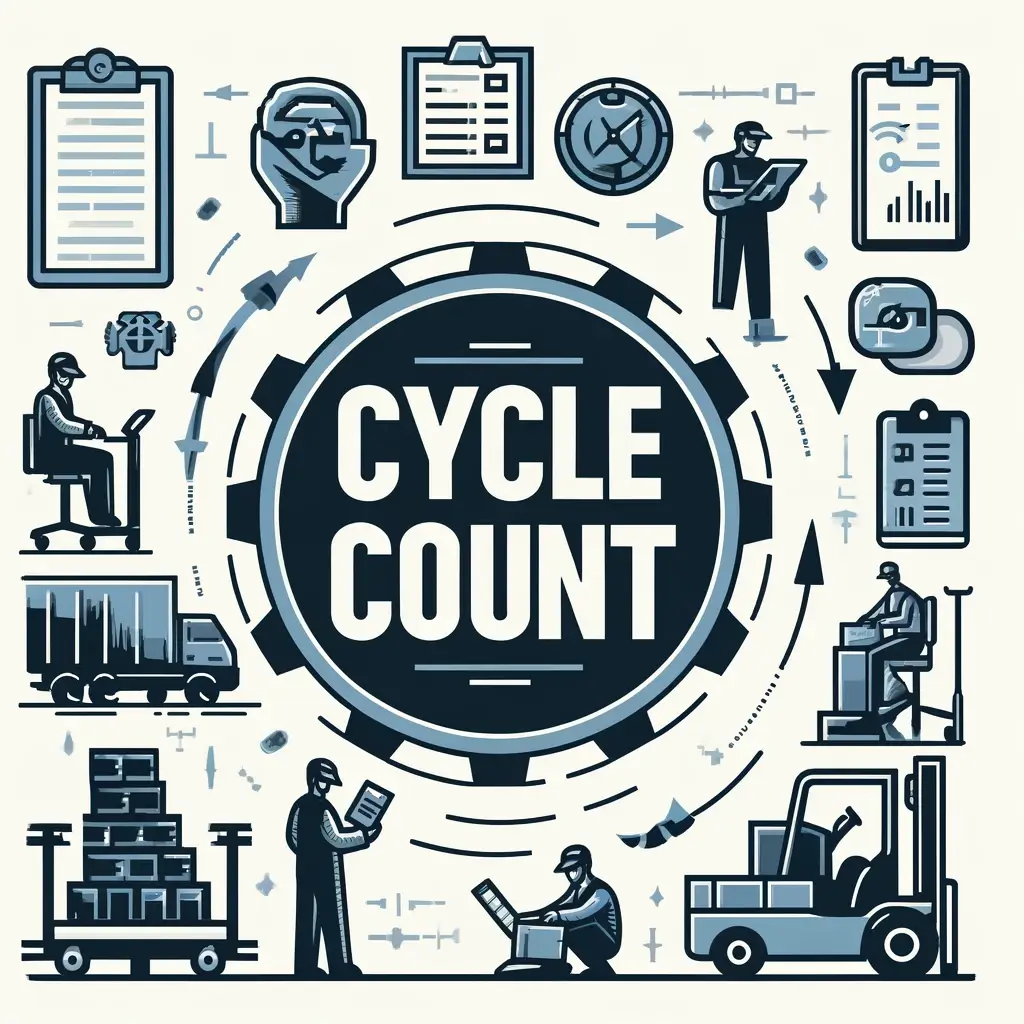The #1 Guide to Cycle Counting: Your Greatest Metric
Did you know that inaccurate inventory can cost businesses anywhere from 10% to 40% of their annual profits? Inventory discrepancies lead to stockouts, lost sales, and frustrated customers. The culprit behind this hidden drain? Outdated or inefficient inventory management practices.

Are you tired of scrambling to fulfill orders because your inventory system doesn’t reflect reality? Do you suspect your warehouse might be harboring a hidden stash of “lost” products? If so, it’s time to embrace counting inventory, a powerful tool for achieving inventory accuracy and boosting your bottom line.
Mastering Inventory Efficiency with Cycle Counting
Inventory management is a constant balancing act for businesses of all sizes. You need enough stock to meet customer demand but not so much that your capital gets tied up in idle inventory. This is where cycle counting comes in.
This inventory counting method audits your inventory on a regular basis but in smaller, more manageable sections rather than counting everything at once.
This approach provides a more accurate picture of your inventory levels throughout the year, helping you identify discrepancies and improve your overall inventory management efficiency.
In this ultimate guide, we’ll explore everything you need to know about this essential inventory management technique. We’ll cover the benefits, the different methods you can use, and best practices for implementing a successful program in your business.
By the end of this guide, we will equip you with the knowledge and tools to leverage:
- Improved inventory accuracy
- Reduced stockouts and overstocks
- Lower carrying costs
- Enhanced forecasting and planning capabilities
- Boosted customer satisfaction
So, if you’re ready to take control of your inventory and unlock the path to greater efficiency, keep reading!

Building a Strong Foundation
Counting inventory is a method for ensuring inventory accuracy without disrupting your entire operation. In the first part of this blog, we explored the benefits and different types of cycle counts. Let’s build a strong foundation for implementing cycle counting in your business.
What is an Inventory Count?
An inventory count is a continuous process of verifying physical inventory against system records for a subset of your items. Unlike a full physical count, which happens once a year (or less frequently), the cycle count process regularly focuses on smaller groups of items. Over time, all your inventory gets counted, providing a more accurate picture of your stock levels.
What Does Inventory Cycle Count Mean?
Inventory cycle count means establishing a system for regularly checking the physical quantities of your inventory against what your records show. This ongoing verification helps identify discrepancies and maintain accurate stock data.
Inventory Cycle Count Policy
An inventory cycle count policy outlines the procedures for conducting cycle counts in your business. This includes details like:
- Selection criteria: How you choose which items to count (e.g., high-value items, fast-moving items)
- Frequency of counts: How often each item gets counted (e.g., daily, weekly, monthly)
- Counting procedures: Standardized steps for conducting the physical count * Variance investigation and resolution:* Process for investigating and resolving discrepancies between physical counts and system records.
Physical Inventory vs. Cycle Counting
While both methods aim to verify inventory accuracy, there are key differences:
Physical Count
- Counts all inventory items at once
- Typically done annually (or less frequently)
- Disrupts operations and requires a shutdown
- Provides a snapshot of inventory accuracy at a specific point in time
Cycle Count
- Counts a subset of inventory items regularly
- Minimally disruptive to operations
- Provides ongoing monitoring of inventory accuracy
- Identifies trends and root causes of inventory discrepancies
Understanding these distinctions will help you decide which method, or a combination of both, best suits your business needs.
Implementing Cycle Counting in Your Business
Now that you understand the core concepts of cycle counting, let’s explore how to implement it.
How to Do Cycle Counting
- Develop an inventory cycle count policy: This document outlines your plan for cycle counting, referencing the details covered in the previous section (selection criteria, frequency, procedures, etc.).
- Prepare for the count: Organize your inventory by location and identify the items to be counted in the first cycle. Ensure clear labeling and easy access to these items.
- Conduct the count: Assign trained personnel to perform the physical count according to established procedures. Utilize cycle counting checklists to ensure accuracy and consistency.
- Record and reconcile: Document and compare the physical counts to system records. Investigate and resolve any discrepancies identified.
- Analyze and improve: Review cycle count data to identify trends and areas for improvement. This can reveal issues like shrinkage or picking errors, allowing you to refine your inventory management processes.
10 Inventory Best Practices
- Clearly define your cycle counting policy.
- Classify your inventory based on value and risk.
- Set realistic counting frequencies based on classification.
- Train staff on proper counting procedures.
- Utilize cycle counting checklists to ensure consistency.
- Rotate counting tasks to minimize bias.
- Perform cycle counts at unexpected times.
- Investigate all discrepancies and implement corrective actions.
- Analyze cycle count data to identify trends and root causes.
- Continuously improve your cycle counting program.
Counting Automation
Technology can significantly enhance your cycle counting process. Integrating your inventory management system with ERP (Enterprise Resource Planning), accounting, and CRM (Customer Relationship Management) systems streamlines data collection and analysis. Additionally, mobile barcode scanners can improve counting speed and accuracy.
ERP, Accounting, CRM Systems Support
These integrated systems can play a crucial role in cycle counting by:
- Providing real-time inventory data for comparison with physical counts.
- Facilitating the creation and management of cycle count schedules.
- Automating discrepancy notifications and resolution workflows.
- Generating reports and analytics to identify trends and improve overall inventory accuracy.
By leveraging technology, you can streamline your cycle counting program and gain valuable insights to optimize inventory management.

Benefits and Challenges
Now that we’ve covered the how-to aspects of cycle counting, let’s examine the advantages and potential drawbacks of this method.
Inventory Benefits
- Improved inventory accuracy: Cycle counting provides continuous monitoring, resulting in more accurate inventory data compared to infrequent full physical counts.
- Reduced stockouts: Accurate stock levels help prevent stockouts and ensure you have the right products available to meet customer demand.
- Enhanced operational efficiency: By minimizing disruptions from full inventory counts, cycle counting frees up staff time and resources for other tasks.
- Lower inventory carrying costs: Accurate inventory data enables optimized ordering and reduced safety stock levels, thereby minimizing storage and carrying costs.
- Early identification of inventory discrepancies: Cycle counting helps uncover shrinkage, picking errors, or other issues early on, allowing for prompt investigation and corrective action.
Challenges and Risks
- Initial investment: Implementing a cycle counting program may require an investment in training, technology (such as barcode scanners), and potentially additional personnel.
- Policy development and adherence: A well-defined policy and consistent implementation are crucial for success.
- Data accuracy reliance: The effectiveness of cycle counting hinges on the accuracy of your existing inventory management system data.
- Potential for human error: Counting errors can occur, so proper training and counting procedures are essential.
How Often Should You Count Your Inventory?
The optimal cycle counting frequency depends on several factors, including:
- Item value and criticality: High-value or fast-moving items require more frequent counting.
- Inventory turnover rate: Items with high turnover rates necessitate more frequent cycle counts.
- Past inventory discrepancy history: Items with a history of discrepancies may need to be counted more often.
There’s no one-size-fits-all answer. However, a good rule of thumb is classifying your inventory based on these factors and assigning counting frequencies accordingly. For instance, high-value or critical items might be counted weekly, while less critical items could be counted monthly or quarterly.
Understanding the benefits and challenges can help you decide whether cycle counting is right for your business. In the next part of this series, we’ll explore strategies for analyzing cycle count data and using it to improve overall inventory control.

Strategies
Having explored the implementation aspects and weighed the pros and cons, let’s delve into strategies for optimizing your cycle counting program.
Cycle Count vs. Physical Count: How to Choose
While both methods aim for inventory accuracy, they have distinct characteristics:
| Feature | Physical Count | Cycle Counting |
|---|---|---|
| Counting Scope | Entire inventory at once | Smaller subsets of inventory regularly |
| Frequency | Annually (or less frequently) | Regularly throughout the year |
| Disruption to Operations | High (requires shutdown) | Minimal disruption |
| Accuracy Snapshot | Provides a picture at a specific point in time | Provides ongoing monitoring for better accuracy |
A yearly physical count might suffice for businesses with slow-moving inventory or limited resources. However, cycle counting offers significant advantages for most businesses, especially those with dynamic inventory or high order volumes.
Both methods can be most effective in many cases, with cycle counting providing ongoing monitoring and a periodic full physical count serving as a final check.
Optimizing With Inventory Management Software
Technology can significantly enhance your cycle counting program. Inventory management software integrated with ERP (Enterprise Resource Planning), accounting, and CRM (Customer Relationship Management) systems streamlines data collection and analysis. Here’s how:
- Real-time data access: Software provides instant access to inventory data for comparison with physical counts.
- Automated scheduling: Create and manage cycle count schedules electronically, ensuring consistent execution.
- Discrepancy management: Automate notifications and workflows for investigating and resolving discrepancies.
- Reporting and analytics: Generate reports to identify trends in inventory discrepancies, allowing you to pinpoint root causes and improve overall accuracy.
Investing in inventory management software can significantly enhance the efficiency and effectiveness of your cycle counting program.
The Frequency of Cycle Counting Methods
The optimal cycle counting frequency depends on several factors:
- Item value and criticality: High-value or fast-moving items typically require more frequent counting (e.g., weekly).
- Inventory turnover rate: Items with high turnover rates necessitate more frequent cycle counts (e.g., monthly).
- Past inventory discrepancy history: Items with a history of discrepancies may need to be counted more often.

Inventory Best Practices
- ABC Cycle Counting: Prioritize counting based on value and criticality. Classify your inventory into A (high-value, frequent count), B (medium-value, moderate count), and C (low-value, less frequent count) categories.
- Random Sample Counting: Select a random sample of items across categories to assess overall inventory accuracy without a full count.
- Control Group Cycle Counting: Consistently count a pre-determined group of items throughout the cycle counting period to monitor overall accuracy and identify potential systemic issues.
A Simple Guide to Counting Inventory
While cycle counting offers significant benefits, remember to establish clear procedures and adjust as needed. This includes:
Implementing Necessary Procedures: Develop a documented cycle counting policy outlining selection criteria, frequency, counting procedures, and discrepancy resolution.
Adjusting Inventory Records: Promptly update inventory records after each cycle count to reflect physical inventory levels.
The Challenges of Counting Inventory
While cycle counting offers numerous advantages, it’s not without its challenges:
- Initial Investment: Implementing a program may require investment in training, technology, and potentially additional personnel.
- Policy Adherence: Consistent implementation of the cycle counting policy is crucial for success.
- Data Accuracy Reliance: The effectiveness hinges on the accuracy of your existing inventory management data.
- Potential for Human Error: Counting errors can occur, so proper training and counting procedures are essential.
A Step-By-Step Guide to Conducting a Cycle Count
- Develop a Cycle Counting Plan: Define your selection criteria, frequency, and procedures.
- Prepare for the Count: Organize inventory, identify items to be counted, and ensure clear labeling and accessibility.
- Conduct the Count: Utilize trained personnel and established procedures to perform the physical count.
- Record and Reconcile: Document physical counts, compare them to system records, and investigate discrepancies.
- Analyze and Improve: Review data to identify trends and areas for improvement in inventory management processes.
Advantages and Disadvantages
We’ve explored the benefits throughout this series. Here’s a quick recap of the advantages and disadvantages:
Advantages:
- Improved inventory accuracy
- Reduced stockouts
- Enhanced operational efficiency
- Lower inventory carrying costs
- Early identification of inventory discrepancies
Disadvantages:
- Initial investment required
- Policy development and adherence
- Data accuracy reliance
- Potential for human error
By understanding both sides, you can make an informed decision about cycle counting for your business.
Conclusion: Taking it to the Next Level
This blog series provided a foundation for understanding and implementing cycle counting in your business. Remember, cycle counting is an ongoing process. Here are some next steps:
- Best Practices for Inventory Cycle Counting: Continuously refine your cycle counting program using best practices like ABC analysis and data-driven adjustments.
- Inventory Counts and Their Impact on Business Efficiency: Track the impact of cycle counting on your inventory accuracy and overall business efficiency. Use cycle count data to identify areas for improvement across your inventory management processes.
- Cycle Counting FAQs: Research frequently asked questions to address any lingering uncertainties.
Additional Resources
- Inventory Management, Human Capital Management: Explore resources that complement your cycle counting knowledge by delving deeper into inventory management practices and human capital considerations for effective implementation.
- Advanced Inventory Forecasting Techniques: Investigate advanced inventory forecasting techniques to further optimize your inventory management strategy.





